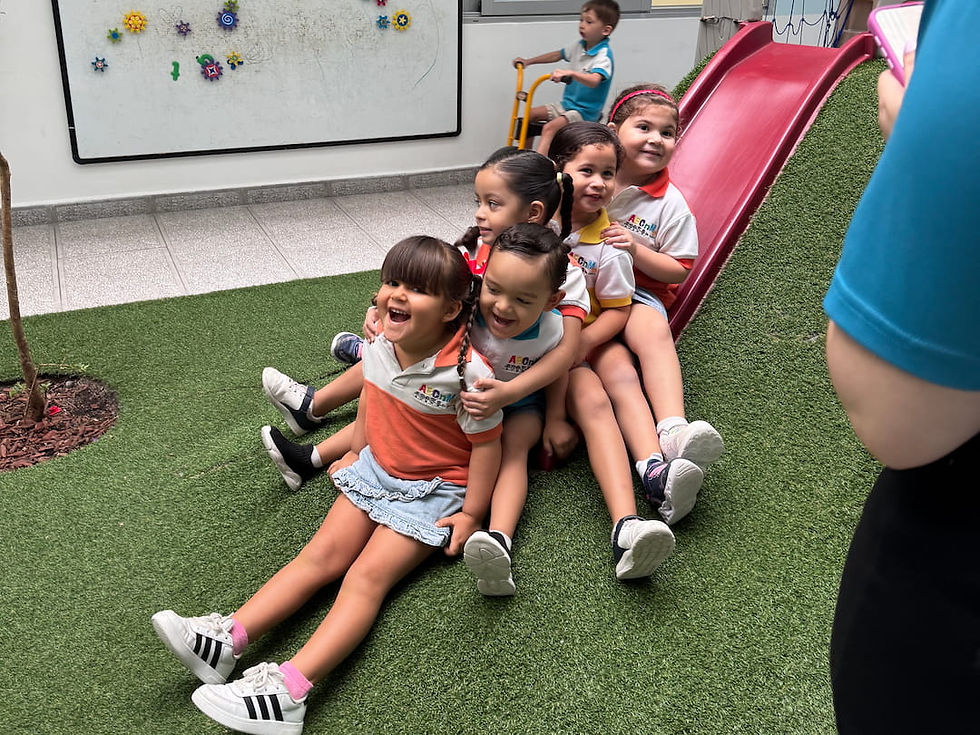Why your Child Needs Outdoor Time during Vacations
- Marianela de Sousa
- Jul 23
- 3 min read
We know mid-year vacations don’t always mean time off for everyone. Some parents still have to work, others are juggling routines, and sometimes, there just isn’t space for big plans. That’s why we wrote this blog — to offer real, practical ideas that support your child’s well-being.
Maybe your child will join a camp or a workshop (wonderful!). But if not, that’s okay too. You can still offer valuable experiences at home or with simple outings. This school break is a chance for your child to truly disconnect, and today we explain to you why and how outdoor time during vacations is important for your child, with examples an ideas to help you out.

What do kids really need during vacation?
Children’s bodies and brains need movement, free play, and contact with nature. Beyond academics, development is strengthened when kids climb, run, explore, and engage with the world through their senses.
What does neuroscience say?
Experts like Carla Hannaford (Smart Moves) and John Ratey (Spark) show that physical activity is directly connected to attention, memory, self-regulation, and creativity. Moving the body helps organize and activate the brain. Outdoor time also reduces cortisol (the stress hormone) and increases dopamine and serotonin, which are linked to emotional stability and well-being.
So, why choose outdoor time during vacations?
Because your child’s development doesn’t only happen in the classroom — it’s shaped by what they live through play, movement, and connection with the world around them.
What if I don’t have time or resources for big plans?
We get it. That’s why here are some simple, low-cost ideas:
Neighborhood walks at sunset
Fresh air and good conversation.
Picnic in the closest park
Or even on a balcony or backyard).
"Explorer for a day"
Collect leaves, spot bugs, or draw what they see outside.
Cooking Time at home
Make a simple recipe together — great for language, math, motor skills.
Barefoot play
Supervised time on grass or dirt builds balance and connection to the environment.
Helpful chores turned into play
Watering plants, sorting toys, folding clothes — it all counts!
What if they’re staying with a caregiver?
Leave a small “activity kit” ready: chalk, bubbles, jump rope, drawing notebooks. You can suggest short routines that include outdoor play even on the sidewalk or in a courtyard.
A quick note on screens
While this blog isn’t about screen time, it’s worth mentioning: some studies show that no screens at all is best for young children. Others are more flexible, but all agree on one point — screen use should be very limited. Screens can’t replace real play, fresh air, or human connection.
The best gift? Your presence
You don’t need a packed schedule of activities. What matters most is something far more powerful: your presence. Even small moments — your attention, your willingness to share something simple — have a lasting impact. Your child doesn’t need big plans; they need to feel seen, heard, and loved.
Going outside, cooking together, jumping in puddles, or walking and talking, are all activities that strengthen your bond and support their development. As the Fundación América por la Infancia (2020) reminds us, free movement and play are “vital needs for a child’s neurological, emotional, and social development.” Save the Children España (2022) emphasizes that outdoor play is a right, not a luxury. And the American Academy of Pediatrics advises keeping screen time minimal — because nothing replaces meaningful, active time. These weeks can be a chance to reconnect through the little things. Because what children need most is time with us.
Cited sources
Fundación América por la Infancia (2020). La importancia del juego y el movimiento en el desarrollo infantil. https://americaporlainfancia.org/wp-content/uploads/2020/06/Juego-y-Movimiento-en-el-Desarrollo.pdf
Save the Children España (2022). El derecho al juego: más allá del entretenimiento. https://www.savethechildren.es/publicaciones/derecho-al-juego
American Academy of Pediatrics (2016). Media and Young Minds. https://publications.aap.org/pediatrics/article/138/5/e20162591/60347/Media-and-Young-Minds






Comments